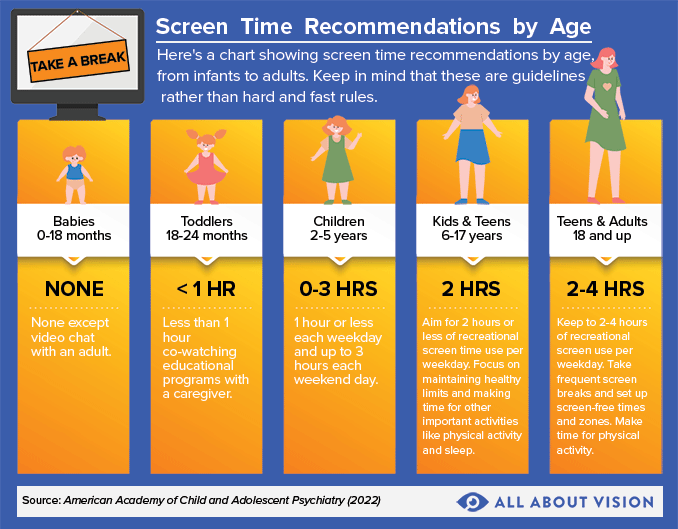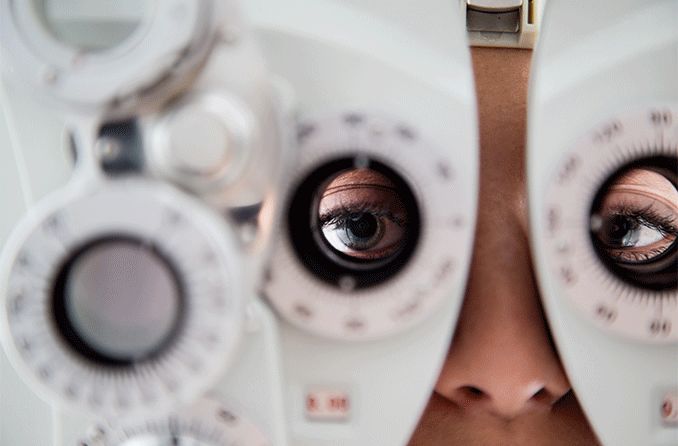How much screen time is right for your child?
Do you check your phone every few minutes, scroll through social media and spend evenings binge-watching new series on Netflix? Given your own screen time habits, you may find it hard to say no when your kids want to play Toon Blast, watch TV or TikTok videos, or text their friends for hours.
But too much screen time for kids may be linked to nearsightedness (myopia), which is becoming more common, and may also lead to eye strain, neck and shoulder pain, headaches, and a more sedentary lifestyle.
To find a healthy balance, you may benefit from making a family media plan. Here's a guide to daily screen time recommendations by age to get you started setting healthy limits for you and your kids.
Average screen time by age
So how much time do kids spend looking at a screen? It varies by age, and it’s increased since the pandemic started. Listed below are average daily screen times by age group:
Average screen time for kids ages 0 to 2 – 49 minutes a day
Average screen time for kids ages 2 to 4 – 2 to 2.5 hours a day
Average screen time for kids ages 5 to 8 – Over 3 hours a day
Average screen time for tweens ages 8 to 12 – Almost 5 hours a day
Average screen time for teens – Almost 7.5 hours a day
These estimates include time spent on entertainment like apps, video games, TV and movies, but do not include screen time spent doing homework or other educational activities. As these are averages, many children in today's world exceed these estimates.
A study published in JAMA Pediatrics in November 2021 found that a group of 12- to 13-year-old children are spending 7.7 hours a day on non-school screen time. That’s about twice as much as the 3.8 hours of screen time they were getting each day before the pandemic.
The reality is, many kids and adults spend a lot of time in front of screens. Now let's take a look at average screen time recommendations by age for babies, toddlers, teens, tweens and adults.
Screen time recommendations for babies up to 18 months old
Zero screen time, except for video chats with family
Babies under 18 months old should have no access to smartphones, tablets or TVs. In other words, try for zero screen time.
There's one exception to this guideline: Facilitating a video chat between your baby and a family member or friend. For example, if a parent is away or a grandparent lives out of state, it's fine to set up a video chat between them and your baby, according to the American Academy of Pediatrics (AAP).
Never before has there been a generation of infants and toddlers who have experienced the amount of near visual demands as those presented by modern digital devices. The excess stress on their visual systems and the high level of sensory stimulation from screens is daunting.
Screen time recommendations for toddlers 18 months to 2 years old
Less than 1 hour per day
Limit media to quality educational programs that you watch together
As your baby becomes a toddler, continue limiting their screen time. It's best if tots ages 18 to 24 months do not have access to phones or tablets to use on their own.
When you introduce digital media to your child, it's important to consider both the amount of time they may spend in front of a screen and also the type of content. Toddler screen time should be limited to watching educational content with a parent or other caregiver.
Try to avoid the temptation to hand your phone to your toddler if they start to fuss. This inhibits their ability to interact with their environment and the people around them.
Screen time recommendations for children ages 2 to 5 years
Less than 1 hour per weekday and less than 3 hours per weekend day
Limit media to educational, interactive programs you can watch or play together
Kids ages 2 to 5 years should still have less than an hour of screen time each day. If you’re ready to let them watch a TV show or play a game on their own, a larger device (like a tablet or computer) will cause less visual stress than a phone.
Screen time recommendations for children and teens ages 6 and over
Aim for less than 2 hours of recreational screen time use per weekday
Maintain healthy limits on screen time and content
Focus on making time for other important activities: 1-2 hours of physical activity, a full night’s sleep, meals as a family, screen-free relaxation time
As a general rule, limit recreational screen time for kids ages 6 to 10 to less than two hours per day. For screen-free time, plan healthy family activities like walks, bike rides and game nights. When kids do use screens, talk about the benefits of mixing in some educational content.
Parents can start talking to kids ages 6 and up about the effects of screen time and why it’s important to set limits. Communicate the rules directly to your child in addition to the consequence if rules are not followed.
Tweens and teens may spend a fair amount of time on screens doing homework and other educational activities. Try to keep recreational (or entertainment) screen time for kids ages 11 to 17 under two hours each weekday.
Limiting screen time in this way will allow time for physical activity and non-screen activities with family and friends. Help your kids become good digital citizens. Talk to them about maintaining online privacy and the consequences of cyberbullying. You may want to put limits on the content they can watch and "friend" them on social media.
Encourage your kids to get at least one hour of physical activity each day and the recommended amount of sleep for their age. It’s critical at this stage that devices are removed from the bedroom. Tweens’ and teens’ sleep quality is vital and is tremendously disrupted when devices are present.
Screen time recommendations for adults
Limit recreational screen time to 2-4 hours a day
Keep work-related screen time around 8 hours a day if you can
Take frequent screen breaks and set up screen-free times and zones
Make time for physical activity
Many adults spend hours in front of a screen each day at work. For a healthy balance, try to limit your screen time outside of work. Adults should try to limit total screen time to eight hours a day for work plus two to four hours for entertainment.
Plan your screen time rather than reaching for your phone or tablet without thinking. If you're in the habit of checking your phone every few minutes out of habit or scrolling endlessly through social media, try putting your device in another room so you have to get up to check it.
Screen time recommendations by age chart

How to limit screen time: Tips and tricks
Do you and your kids spend more time than you'd like in front of a screen? Consider setting screen time limits based on the recommendations above. Here are a few guidelines on how to limit screen time in your family:
Make a family media plan. HealthyChildren.org, from the American Academy of Pediatrics, offers an interactive tool with a screen time calculator and media plan builder. It uses the ages of your kids to provide personalized recommendations.
Swap in educational content. Encourage your kids to use some of their screen time for educational content. The nonprofit Common Sense Media offers lists of quality educational apps, games and websites for kids by age.
Strive for balance. When trying to limit screen time in your family, go for balance. Choose non-screen activities to do as a family and schedule time for physical activity and sleep.
Set a "screen time curfew." Make it a family rule to put away devices during meals and family activities. Have your kids put their devices up for the night at the family charging station an hour before bedtime.
As a parent, it’s important to help your kids build healthy habits around digital screen use in your home. Using these screen time guidelines and creating a family media plan are great ways to start. Keep up the good work with annual comprehensive eye exams for the whole family.
Not sure what to do without a screen? Check out this list of 101 screen-free activities put together by the team at Screen-Free Week .










